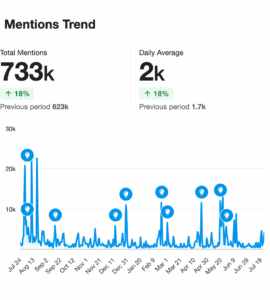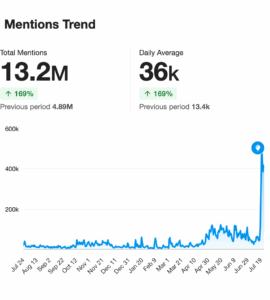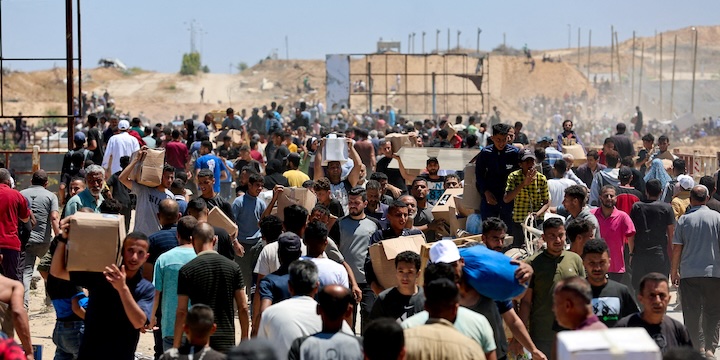Palestinians carry aid supplies which they received from the US-backed Gaza Humanitarian Foundation, in the central Gaza Strip, May 29, 2025. Photo: REUTERS/Ramadan Abed/File Photo
It’s important to preface the following with an acknowledgment that food insecurity at any level should not be taken lightly, and that every civilian death is a tragedy. It’s also important to emphasize the following:
- Hamas is exploiting Gazan civilians, because it is in their interest to exacerbate the humanitarian crisis in Gaza.
- They have also managed to convince the world that Israel is responsible and have removed themselves from the narrative.
- The international media is playing along.
- Even when the IDF took real action, including a press tour to see all of the aid waiting to be picked up for distribution and a subsequent aid air-drop, the aid waiting at the border was barely covered and the media narrative did not change.
Claims of mass starvation in Gaza are being misrepresented by major media outlets, often based on Hamas-supplied narratives and without sufficient fact-checking or context. Images of children — skin and bones — are now appearing across Western media, blaming the Gaza Humanitarian Foundation (GHF) and Israel for the hunger crisis.
Of course, images like these evoke emotion. It’s also not surprising that people would stand against Israel or Israeli operations in Gaza. But the media leave out this fact: Hamas controls the narrative, and the UN refuses to cooperate with Israel and the GHF, because it also has an interest in furthering that narrative. That means refusing to find a solution that bypasses Hamas.
So, What’s Really Happening on the Ground?
First and foremost, let’s begin with this fresh video proof of Hamas terrorists in one of their underground tunnels, enjoying plentiful amounts of food while civilians above ground suffer, and Israeli hostages are tortured and starved:
In response to claims by the UN and others that aid is not being let into Gaza, the IDF’s unit for Coordination of Government Activities in the Territories (COGAT) posted this clip on their X account on Tuesday:
What you need to know about humanitarian aid for #Gaza:
Since May 19, and in accordance with the directive of the political echelon, aid enters Gaza through two primary channels:
1. Distribution sites operated by @GHFUpdates, where weekly food packages are provided to… pic.twitter.com/eLIQ1ELY6M
— COGAT (@cogatonline) July 22, 2025
UN aid, 950 truckloads of it to be exact, had been left to rot on the Gaza side of the Kerem Shalom border crossing, and the UN’s story constantly contradicts itself.
Two days after the video was released online, exposing the UN for putting politics before people, the UN and other organizations began collecting boxes from the crossing — prompting updates on re-openings of food kitchens across the Strip. There are now reports of around 400 truckloads left waiting to be picked up.
Documents belonging to the The World Food Programme (WFP), a UN aid organization, show that Israel is trying to work with the UN to facilitate aid entry into Gaza. It is also clear that aid trucks are getting looted.
The Israeli authorities report that there is no limit at on the number of trucks that can be manifested. Trucks are permitted to bring cargo to crossings so long as there is capacity to collect the cargo inside Gaza.
Fox News Chief Foreign Correspondent Trey Yingst reveals more about negotiations between Israel and the UN:
Hundreds of trucks worth of aid is sitting inside Gaza, as we reported days ago.
Five separate routes were offered to the UN to distribute this aid, I’m told.
Palestinian civilians are in desperate need of this humanitarian support.
— Trey Yingst (@TreyYingst) July 23, 2025
150 aid trucks were collected by the UN inside Gaza. An additional 70 trucks were unloaded at aid crossings.
Again, this is the result of negotiation that is taking place directly between UN and Israeli officials who are speaking nearly every day.
— Trey Yingst (@TreyYingst) July 24, 2025
On Thursday, the IDF hosted a group of international press workers at the Gaza side of the Kerem Shalom crossing to see the aid waiting to be picked up:
Today, the IDF invited dozens of international journalists to the Kerem Shalom crossing inside Gaza, to see for themselves.
Hundreds of aid trucks have entered Gaza with Israel’s approval, but the supplies are standing idle, undelivered.
The reason?
The UN refuses to distribute… pic.twitter.com/IqRRAwmTHi— Israel Foreign Ministry (@IsraelMFA) July 24, 2025
The Media Echo-Chamber
On Sunday morning, Israel announced that air drops of humanitarian aid, in coordination with Jordan and the UAE, backed by the UK had begun. The media were quick to criticize.
The BBC’s Jeremy Bowen, for one, emphasizing that it is a last-resort option and he claims, there are still other options:
Air dropping aid is an act of desperation. It can also look good on television, and spread a feel-good factor that something, at last, is being done.
While his argument about aid drops being dangerous hold merit, there clearly is desperation, and clearly this is Israel showing that it is making every attempt possible to facilitate aid. This is not to create a “feel-good factor.” With all due respect to Bowen, this may be the most efficient and quickest way to deliver aid at the current moment.
But it seems that no matter what is done to try to facilitate aid distribution, the media and the UN for that matter, find a reason why it is inhumane or not good enough. There are complaints about driving it through Gaza (as their trucks are looted), there are condemnations over asking Gazans to come to aid centers to pick up aid themselves, and the US’ temporary pier that brought in tons of aid, which ended up being a wasted effort, as most of it just sat there to rot because aid organizations also refused to pick it up.
Media coverage following the press visit to the Kerem Shalom crossing was also abysmal by outlets like The Telegraph, dismissing every single Israeli comment as either casting doubt, or ignoring the facts on the ground — that the UN denied assistance from both the IDF and the GHF.
From the first sentence, the legitimacy of the clip is questioned:
Israel has given a tour of a large storage site within Gaza containing what it claims to be 1,000 lorries-worth of aid that the United Nations (UN) has failed to deliver.
But the UN has said that, in practice, Israel is not facilitating the distribution of its aid in Gaza.Stéphane Dujarric, the UN spokesman, said the country was imposing “tremendous bureaucratic impediments” and “tremendous security impediments.”
And then completely closing its eyes to the fact that the UN can’t deliver its aid without help, and again, won’t cooperate with Israel”:
The full details of why the UN and its NGO partners are unable to deliver aid into Gaza are not clear.But it is believed that the organisation had to adapt its delivery routes and methods from its traditional patterns because of the deteriorating security and humanitarian situation, and that Israel is not facilitating this on the ground.
NBC for its part, completely ignored the hundreds of truckloads sitting at the border, choosing instead to put the blame on Israel rather than address the UN’s failure by giving misguided explainers on “delayed convoys” and “chaotic and often obstructive conditions”:
Aid agencies say they would like to deliver aid, but that Israel has riddled the process with delays and denials, changing schedules and routes, sometimes at the last minute, making it difficult or impossible to safely retrieve the aid for distribution.
This final line in the piece just adds to the questionable reporting. They refer to the Hamas-run police as a legitimate “police-force” — as if it was there to provide security to aid convoys rather than steal it.
Gaza’s police force was also more present and provided security, but months of Israeli bombing have crippled the police and increased desperation among the public.
The BBC ignored the latest developments all together.
As for the hunger crisis itself, The New York Times and NBC were disappointing to say the least.
The New York Times has no qualms about parroting Hamas propaganda filtered through aid agencies and rights groups, blaming the crisis in Gaza on Israel, and not on Hamas, its own ruling power that hoards food and supplies from its population.
In a joint statement released on Wednesday, more than 100 aid agencies and rights groups said Gaza was facing “widespread starvation” and called on Israel to lift restrictions on humanitarian aid.
As previously mentioned, the WFP documented that Israel had no restrictions on aid.
Or NBC’s report on six-week old Youssef al-Safadi, who reportedly died of malnutrition, and the greater spread of starvation in the Gaza Strip. The article both blames Israel and erases Hamas from the conflict.
Israel lifted its blockade in late May but has since allowed only limited aid into the enclave, and Gaza’s population continues to faces dire shortages of basic necessities.
Additionally, the quote above contradicts what was written in WFP’s document about Israel’s efforts to remove any limits of aid entry across whichever border is needed.
The article also managed to shift responsibility for any starvation away from Hamas, rather than explain that Hamas steals, hoards, and up-charges aid.
Doctors and aid groups have warned of a hunger crisis now reaching a climax in the besieged Palestinian enclave under Israeli military assault. Four children were among 15 people who died from severe malnutrition in just 24 hours, the Palestinian Health Ministry said Tuesday. The ministry said Wednesday that another 10 people had died of malnutrition.
Here Israel and GHF statements that aid is indeed coming through the border have been dismissed by using unfounded statements from doctors that no aid is coming in?
There’s just no food,” said Burgos, who is working at Nasser Hospital in Khan Younis and volunteering with the medical NGO Glia. “There is just nothing getting in, hasn’t been getting in for months.”
And finally, no mention of why the UN aid hadn’t been picked up from the border and distributed as it was meant to. Not only are there aid trucks on the Gaza-side of the border, but Hamas warehouses full of UN aid are being looted.
Food has arrived, it’s just not made available to civilians. It’s important to note that Hamas is also making attaining GHF aid a dangerous endeavor. There are reports of terrorists beating, shooting, and stealing aid from hungry people.
The list of problematic media coverage goes on. How does this work? When Palestinians in Gaza are suffering and the world sees, pressure is placed on Israel by the international community to end the war, thus enabling Hamas to have more leverage in negotiations.
The “Evidence” of Gaza Blindness
There is a horrific famine happening in Sudan, with the Integrated Food Security Phase Classification (IPC) reporting famine level hunger in North Darfur IDP camps and the Nuba mountains since 2024. It’s affecting hundreds of thousands, with millions at “phase 3” food insecurity levels or higher, but the media give it half the attention it gives Gaza or even less.
Here are the media mentions (over the last year) of the words “Sudan” and famine related terms across all types of media and all outlets — and then “Gaza” with the same parameters. Filters were set to include all mentions across the web:

Sudan

Gaza
How is Sudan’s humanitarian crisis so underreported and ignored compared to Gaza’s, when 24.6 million Sudanese people are suffering from acute hunger levels?
The answer? Hamas is lurking in the shadows of media lies. Evidently, Gaza is a twilight zone — almost as if it exists in a parallel media reality where logic and truth are blurred. Readers must be able to see past the picture and into the truth, but in order to do that, the media must regain integrity and ask the hard questions. Which party is the real obstacle and could end this war today? Hamas.
The author is a contributor to HonestReporting, a Jerusalem-based media watchdog with a focus on antisemitism and anti-Israel bias — where a version of this article first appeared.
The post The Food Situation in Gaza Is More Complicated Than What’s Being Reported first appeared on Algemeiner.com.
Click this link for the original source of this article.
Author: Channa Rifkin
This content is courtesy of, and owned and copyrighted by, https://www.algemeiner.com and its author. This content is made available by use of the public RSS feed offered by the host site and is used for educational purposes only. If you are the author or represent the host site and would like this content removed now and in the future, please contact USSANews.com using the email address in the Contact page found in the website menu.








